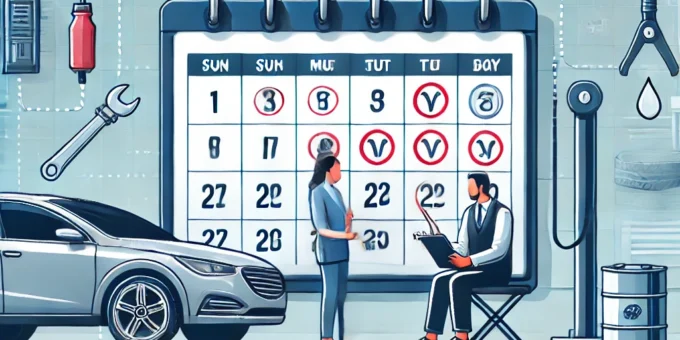
Regular car maintenance is essential to keeping your vehicle running smoothly and avoiding costly repairs. However, many car owners struggle to interpret their car’s maintenance schedule or don’t realize its importance. By understanding your car’s maintenance schedule, you can ensure your vehicle stays in top condition, lasts longer, and performs efficiently.
This guide will walk you through what a car maintenance schedule is, how to follow it, and why sticking to it is vital. Whether you’re a first-time car owner or just looking to improve your maintenance habits, this guide will simplify the process.
What Is a Car Maintenance Schedule?
A car maintenance schedule is a detailed plan that outlines when specific maintenance tasks need to be performed on your vehicle. It’s typically based on:
- Mileage Intervals: Services are due after a certain number of miles (e.g., every 5,000 or 15,000 miles).
- Time Intervals: For cars that aren’t driven much, services are recommended after a certain period (e.g., every 6 months).
Example: Your car’s maintenance schedule might specify oil changes every 5,000 miles or 6 months, whichever comes first.
Why Is Regular Maintenance Important?
Adhering to your car’s maintenance schedule provides several benefits:
- Improved Safety: Routine checks ensure brakes, tires, and other critical systems are functioning properly.
- Enhanced Performance: Maintenance keeps your car running smoothly and efficiently.
- Reduced Repair Costs: Preventative maintenance helps you catch minor issues before they become major (and expensive) problems.
- Better Resale Value: A well-maintained car with service records is more appealing to buyers.
- Prolonged Lifespan: Cars that are serviced regularly tend to last longer.
Step 1: Locate Your Car’s Maintenance Schedule
The first step to understanding your car’s maintenance schedule is knowing where to find it.
- Owner’s Manual: The maintenance schedule is usually included in the manual that came with your car. Look for sections labeled “Maintenance” or “Service Schedule.”
- Manufacturer Websites: If you’ve misplaced your manual, many manufacturers provide maintenance schedules online.
- Service Centers: Authorized dealerships and mechanics can also provide a printed schedule tailored to your car’s model.
Tip: Keep the schedule handy, either in your car or as a digital file on your phone.
Step 2: Understand the Types of Maintenance Tasks
Car maintenance schedules typically include a variety of tasks, such as:
- Oil Changes: Replace engine oil and oil filter to keep the engine lubricated.
- Tire Rotations: Swap tire positions to ensure even wear and prolong tire life.
- Brake Inspections: Check pads, rotors, and fluid for proper braking performance.
- Fluid Checks: Inspect and replace fluids like coolant, transmission fluid, and brake fluid.
- Battery Maintenance: Clean terminals and check the battery’s charge.
- Filter Replacements: Replace air filters and cabin air filters for optimal airflow.
Step 3: Follow Mileage-Based Maintenance Intervals
Maintenance schedules are often organized around mileage milestones.
Common Intervals and Tasks:
- 5,000–7,500 Miles: Oil change, tire rotation, and brake inspection.
- 15,000–30,000 Miles: Replace air filters, check coolant, and inspect suspension components.
- 50,000–60,000 Miles: Replace spark plugs, inspect timing belt, and flush coolant.
- 90,000–100,000 Miles: Replace timing belt (if applicable) and inspect major systems like transmission and steering.
Tip: Refer to your owner’s manual for your car’s specific intervals.
Step 4: Follow Time-Based Maintenance Intervals
If you don’t drive much, you still need to follow a time-based schedule.
Why It Matters:
- Fluids like oil and coolant degrade over time, even if you don’t drive frequently.
- Rubber components like belts and hoses can dry out and crack.
Example: If you only drive 3,000 miles in 6 months, you should still change your oil after 6 months to maintain engine health.
Step 5: Know Which Fluids Need Replacing
Fluids are the lifeblood of your car and must be checked and replaced regularly.
Key Fluids to Maintain:
- Engine Oil: Change every 5,000–7,500 miles (conventional) or 7,500–10,000 miles (synthetic).
- Coolant: Flush and refill every 2–5 years.
- Brake Fluid: Replace every 2–3 years to ensure proper braking performance.
- Transmission Fluid: Replace every 30,000–60,000 miles, depending on your car.
Step 6: Pay Attention to Warning Lights
Dashboard warning lights often indicate maintenance needs.
Common Lights and What They Mean:
- Oil Change Light: Time to replace your engine oil.
- Tire Pressure Monitoring System (TPMS) Light: Check your tire pressure.
- Check Engine Light: Indicates a potential issue that requires diagnosis.
Tip: Use an OBD-II scanner to read error codes for the check engine light.
Step 7: Use Technology to Stay on Track
Apps and tools can help you keep up with your car’s maintenance schedule.
Recommended Apps:
- Carfax Car Care: Tracks maintenance history and sends reminders for upcoming services.
- AUTOsist: Digital logbook for recording and tracking services.
- Drivvo: Helps manage maintenance schedules and expenses.
Step 8: Work with a Trusted Mechanic
A reliable mechanic can help you follow your car’s maintenance schedule and spot potential issues early.
How to Choose a Mechanic:
- Look for ASE certification or manufacturer-specific training.
- Check reviews and ask for recommendations from friends and family.
- Ensure they provide transparent pricing and written estimates.
Common Mistakes to Avoid
- Skipping Scheduled Maintenance: Ignoring service intervals can lead to costly repairs.
- Using the Wrong Fluids: Always use fluids recommended by the manufacturer.
- Relying Only on Mileage: Remember to follow time-based intervals too.